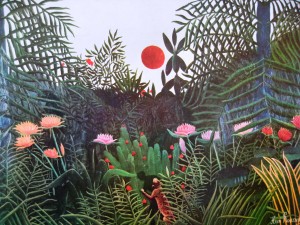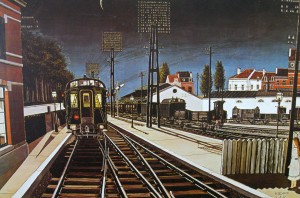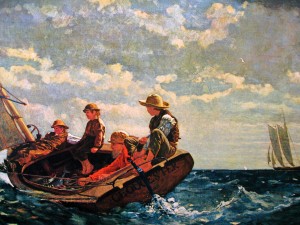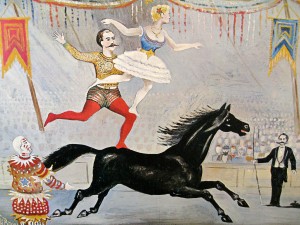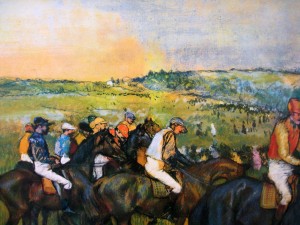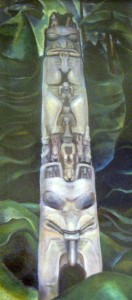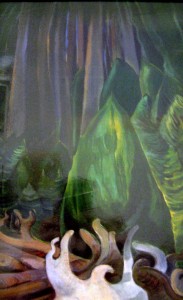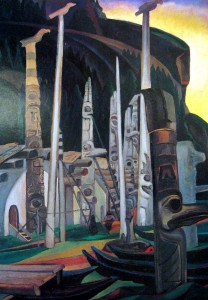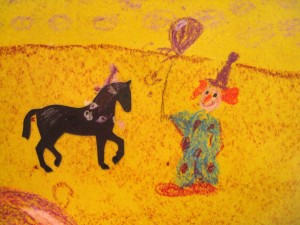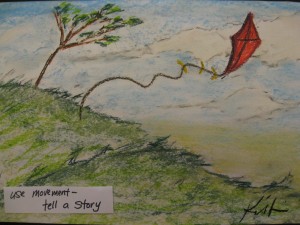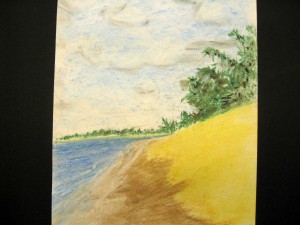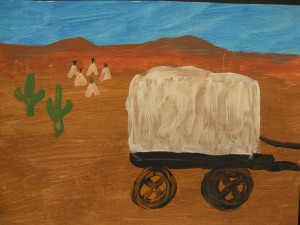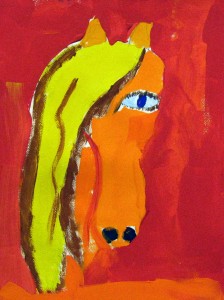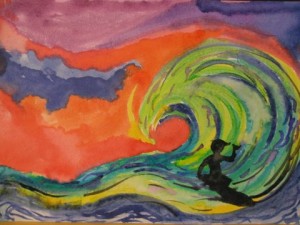1. Dismounted: 4th Troopers by Frederic Remington
2. Virgin Forest by Henri Rousseau
3. Trains du Soir by Paul Delvaux
4. Breezing Up by Winslow Homer
5. Bareback Riders by W.H. Brown
Packet Extras by Northwest Adventurer and Artist Emily Carr
“Kwakuitl House” (1912)
“Totem and Forest” (1931)
“Sea Drift at the Edge of the Forest” (1931)
“Heina, QCI” (1928)
“Kispiax Village” (1929)
Sample Projects:
There are three major objectives for presenting this packet. The primary focus is to get kids sharing and discussing their opinions. Make it a priority to call on the kids who normally keep quiet and do not raise their hands. Opinion questions are often less intimidating. The second focus is to be sure that kids have been exposed to and understand FOREGROUND, MIDDLE GROUND, and BACKGROUND. Finally, focus on exercising observation skills (especially K-1) by choosing questions that require kids to LOOK at the art.
These pictures illustrate various exciting activities or actions occurring, or about to occur, in various locations and times—in other words, IMAGINARY ADVENTURES designed to encourage kids to use their imaginations and consider their own opinions about a variety of topics.
Many of the questions included in the Suggested Dialogue sections do not even directly pertain to Art Basics (COLOR, LINE, SHAPE, PATTERN, MOVEMENT, etc.) this month, although these are not left out. It simply means that there are more open ended questions, the types that require additional brain exercise but which also have a variety of answers and encourage kids to form opinions.
THINKING is really what all of the Art Discovery discussion, all of the questions volunteers ask, as well as most of the suggested art projects, are all about. ART MAKES YOU SMART! Leading questions in Art Discovery materials causes kids to EXERCIZE THEIR BRAINS in ways they are not even aware of! QUESTIONS, especially those requiring opinions, teach much more than TELLING kids the facts!
Be sure to ask questions that will lead kids to learn or review FOREGROUND, MIDDLE GROUND and BACKGROUND. By asking something about FOREGROUND, MIDDLE GROUND or BACKGROUND each month (1-3 questions), and by simply using the vocabulary, kids will eventually come to understand, identify, and use these art terms. This exercise is also a good presentation warm up at every grade level. DO NOT AUTOMATICALLY ASSUME KIDS UNDERSTAND THESE CONCEPTS—EVEN IF THEY ARE OLDER. Unless previous Art Discovery Volunteers have discussed and used the correct vocabulary with them, many kids (even adults) may have never been exposed to all of these (formally worded) art concepts. For the new Washington State 5th grade visual arts assessments, the ability to understand and write comments on these three basic concepts is required.
Make sure ALL 6 pictures are returned to the Packet Carrier after your Presentation is finished!
Create a One-Point Perspective Scene
It’s easy to draw in one-point perspective. Here’s how!
(This is a good project for 5th, 4th, and some third grade classes.)
1. Turn your paper so that it is horizontal (“landscape” orientation).
2. Draw a horizontal line across the width of the page, just above or just below the center. This is your HORIZON LINE. A landscape is more appealing when the horizon line is NOT in the exact center of your page.
3. Place a dot in the center of your horizon line. This is your VANISHING POINT.
4. Draw two vertical lines that start at the vanishing point and extend off the paper. This could be a sidewalk, road, river, or railroad track.
Add trees, bushes, Mountains or Buildings to finish the Landscape.
5. Now, add the details to your landscape. Remember—larger things move forward in the picture, smaller things move back; background objects are paler in color, foreground objects (those closer to the viewer) have more color.
Landscape
A Landscape is a picture of the outdoors. It usually includes mountains, trees, plants, rivers, sky and any other element you might see if you looked out a window. Some landscapes include people, animals, buildings (barns, houses, sheds), roads or streets. Here are a few things to observe when you are looking at a landscape:
- Does the painting show a certain mood or emotion?
- Does the painting have detail, or does it only give an impression of something?
- Does the painting look real, or not very real?
- What is the season?
- What is the period? Historic? Modern?
- Does anything in the painting show movement?
- What do you “see,” “hear,” “feel” or “smell” in the painting?
- Pay attention to the artist’s STYLE—if this artist could paint the landscape we see out of the classroom window, what details might he or she concentrate on, or include? What COLORS would the artist use? Would it look photographic (realistic) or not (expressionistic)?
PERSPECTIVE
In a landscape, an artist creates the illusion of a three-dimensional world on a flat canvas or piece of paper. Artists do this by manipulating the SIZE, PLACEMENT and COLOR of the objects he paints. This is called PERSPECTIVE and here are some things to remember:
- SIZE—objects that are closer (foreground) are larger than objects in the distance (background).
- PLACEMENT has to do with the different areas of a picture—FOREGROUND (The area closest to the viewer or the bottom area of the painting), MIDDLEGROUND (Center area of the picture, things are not as close), BACKGROUND (Things in the distance, on the horizon, that are farthest away from the viewer and the highest area in the picture).
- OVERLAP—Foreground objects can block out part of the things behind them. This helps fool our eyes into thinking that the things in the foreground are closer, in front of the background objects.
- COLOR should fade in the distance (background) of a landscape. Objects that are closer (foreground) have more color. Warm colors (shades of red, orange, and yellow) draw the viewer’s eyes forward. Cool colors (shades of blue, green, and violet) draw the viewer’s eye back across the canvas.
- TEXTURES are more recognizable and detailed in the FOREGROUND. Texture becomes fuzzy in the distance.
- DETAIL is very important. The closer the object, the more detail it has. Objects in the distance often become only simple shapes with color.
- The VANISHING POINT is a very important aspect of perspective. This is the point where the horizontal and vertical lines of the picture meet. The vanishing point gives the picture an illusion of DEPTH, as if the scene could go on forever. The artist could also use the vanishing point to direct the viewer’s eye to a particular place in the picture.
SHADOW and SHADE
Another way an artist fools our eyes and makes a landscape realistic is by creating SHADOW or SHADE. What creates a shadow or shade? Light What creates the light in a landscape painting? The sun (or moon if it is an evening landscape)
Set out all of the landscape pictures at the front of the room. Ask kids to point out the shade and shadows found in each painting. Do ALL of the pictures have shadows and shade? Only the real looking pictures. The brightest and most colorful landscapes are more animated, maybe even a little cartoonish, or make believe. These expressionistic pictures are flatter because they do not have shadows or shade.
Why does an artist add shadow or shade to a picture? To make it look more realistic. Shadow and shade create an illusion of dimension or depth in the picture.
SUGGESTED SHADOW DEMONSTRATION
Darken the classroom. Use a flashlight and a ball to illustrate the following concepts:
- A shadow directly in front of the object means the light source comes from directly behind the object.
- A shadow on the side of an object means the light is coming from the opposite side.
- An almost invisible shadow means the light is directly above the object.
- A shadow above the object means the light is shining from below the object.
Demonstrate by placing something (like a light colored box) directly behind the ball, for the shadow to fall on, before you begin. You might also place the ball on a table against a wall. Ask the kids if they can tell you the direction each different shadow that you demonstrate would be drawn or painted. You might demonstrate this on the board at the front of the room. The suggestion to use a ball is because a ball is very easy to draw and will not take attention away from what is going on with the shadows.
Consider having the kids fold a piece of paper into quarters. As you hold the flashlight in the four different places, the kids could draw the shadow and label the direction the light came from. This becomes a reference sheet to use with their own drawn or painted landscape, to help them add shade and shadows. (Fourth and Fifth Grade)
REAL VERUS UNREAL
Can you think of a type of picture that looks very real? A photograph, movie, DVD or video
Can you think of a type of picture that looks very unreal? A cartoon, comic book, coloring book
In the early days of painting and art, artist did what photographers do now. There were no cameras so artists were commissioned (or hired) to paint pictures of families or individuals. This way the people would not be forgotten when they moved away or died. Artists were also paid to paint special events or places that people wanted to remember. Artists might make mistakes here and there that would make the picture look a little bit different from the person or scene the artist was trying to recreate. Before cameras, paintings were the only way to keep a visual record of anything, so artists tried to make their pictures look as realistic as possible.
Today, we use a camera to take photographs of scenes or people. Photographs reproduce the scene EXACTLY the way they looked in real life. A photograph does not make the little mistakes an artist might. After cameras were invented, in about 1830, artists started to experiment with showing things in ways that a camera could not. Some artists deliberately made things look unreal.
Many of the landscape paintings in this packet are painted in a very realistic style, yet some of them are not. As you show the different pictures, remember to ask if the scene looks real or unreal. It is interesting that the painting Imaginary Landscape looks realistic because it is NOT an actual place.
Why wouldn’t an artist want their picture to look as realistic as possible? An artist might want to create a certain mood or feeling. An artist might want to make the viewer think or look again at the picture. An artist might just want to have fun and play with his painting.
Types of Landscape:
Seascape
A Seascape is a picture of a scene at sea or a scene including a portion of the sea, or a large body of water. This Packet contains a Seascape painted by American Artist, Winslow Homer. Until the mid-1800’s, American painting was closely tied to European art because most important American painters had studied in Europe. Eventually, many American artists felt that the Landscape and scenery of the New World could provide the source for a truly American style. American Landscapes and Seascapes reflected the American artist’s patriotic pride in the magnificence of America. Winslow Home never studied art in Europe. Today, he is considered the greatest painter of American Seascapes who ever lived. The most interest thing about this fact was that Homer had only one art teacher, as a young boy, and that was his own mother! Homer’s mother was raised during Victorian times, when it was considered “proper” for young ladies to learn painting. Yet, it was NOT considered “proper” for young ladies to become professional artists. A Young lady’s responsibility in Victorian times was to become a “proper” wife and mother. Homer’s mother actually had a lot of artistic talent, which she passed on to her son. However, Winslow Homer was mostly a self-taught Seascape painter.
Here are a few things to observe when looking at a Seascape:
- Does the painting show a certain mood or emotion? What are the clues?
- Does the painting look real (like a photograph) or not (expressionistic)?
- What is the name of the STYLE of painting the artist used?
- What can be seen in the FOREGROUND (area closest to the viewer)?
- What can be seen in the MIDDLE GROUND (center area of picture)?
- What is in the distance, the BACKGROUND of the picture?
- What is the time of day? What kinds of clues does the artist give you?
- Does anything in the painting show MOVEMENT?
- What is the Season? Weather? Climate? What clues give you this idea?
- What can you “see”, “hear”, “feel”, or “smell” in this painting?
- What type of medium (material) did this artist use? Can you see any general differences between an oil painting and a watercolor?
1. “Dismounted: The 4th Troopers Moving” by FREDERICK REMINGTON (Born 1861 – Died 1909) American Painter, Sculptor & Writer
About the Artist
Frederic Remington was born in Canton, New York and received art training at the Art Students League in
New York City. Remington is famous for scenes of action usually involving cowboys, troops, horses, and
the Old West. In the Spanish-American War, he served as an artist and correspondent. In the 1890’s, Remington started to make clay models of his subjects, which were then cast into bronze. Along with
Charles Russell, who he is sometimes confused with, Remington is probably the most famous painter of American Western scenes. His achievements include 2700 works of art! (For more information on this
artist, see Packet 17. Frederic Remington—Western Landscapes)
About the Art
This painting is a scene showing a troop of cavalry during the Indian Wars that were fought in the Western United States from 1865 – 1890. We see selected sharp-shooters keeping the enemy busy while the main
body of troops moves off to take a new position. We do not see the enemy, but we sense him in the rapidly galloping horses, in the three riderless horses led by the old soldier with a weather-beaten face, in the flying hooves and the rising dust that marks the brilliant blue sky, and in the men’s faces which are all turned toward the scene of the action.
Suggested Dialogue
Discuss movement. What kinds of movement can be found in this painting? Horses, men, dust
What makes something seem to move in a painting? Angular line? Vertical line? Diagonal line? Curving line? A sense of MOVEMENT or action can be created with the help of both curving and diagonal LINES and SHAPE arrangement.
Have students show MOVEMENT with their bodies, then “freeze.” Try to illustrate a slow movement, a rapid movement and an abrupt movement. How would an artist illustrate these different movements in a Portrait?
Describe what is going on in the picture. Who do you think the unseen enemy is?
Where is the enemy?
Have you ever seen old western movies showing scenes of cavalry charges? Did you ever stop to think what it would have been like to have been a horse soldier? Can you think about it now? Does this print give you a new idea of this type of life? Do you think you would like to do this yourself?
Project Ideas
- Draw a portrait of a cowboy and paint it.
- Create a portrait of a cowboy using cut paper.
- Draw a picture of a horse.
- Sculpt a horse with clay.
- Find pictures or bring in a few pairs of cowboy boots. Point out the different designs used to decorate cowboy boots. Have kids design a fancy cowboy boot using cut paper.
- Create an artist’s action model to help you draw action poses. Cut a pipe cleaner in half. Create a looped head on one end; the rest will be a “torso”. Twist the center of the other half around the wire to attach beneath the head, leaving small vertical section of “neck”. Thread two short sections of straw tubing on each horizontal wire and loop at each end to hold straws in place (“hands”). Wire can now be bent to resemble jointed “arms”. Attach jointed “legs” the same way. Bend model into action poses for drawing action scenes with human MOVEMENT—running, skiing, tumbling, and biking.
2. “Virgin Forest” by Henri Rousseau (RU – so) b. 1844 – d. 1910, French Painter
About the Artist
Henri Rousseau was born in Laval, France. His father was a tinsmith. As a boy, Rousseau had no exposure to art and no formal training. He disliked school, except for the subjects of poetry and music. As a soldier and musician with the French Army in Mexico, he was impressed by the semi-tropical scenery, and it inspired much of his later art work. It was when Rousseau moved back to Paris and went to work at a little toll house that he began to paint. His nickname was “Le Douanier” – the customs collector. Many things fascinated Rousseau, who was a self-taught Folk Artist or Primitive Artist (An artist without formal art training). He would spend hours sketching huge exotic palms and flowers. He also loved visiting the zoo. Foliage and exotic animals are often the subjects of his imaginative and primitive paintings.
About the Art
Some artists paint what they see, others what they imagine. Henri Rousseau, famous for his jungle scenes, never actually saw a jungle. He was inspired by ordinary houseplants in a Parisian botanical garden – he exaggerated them to create works like “Exotic Landscape” and “Virgin Forest”. Rousseau is considered as a primitive artist because he was self-taught. In the fantasy jungle a red sun is setting on the horizon and huge leaves, flowers and blades of grass stand taller than the head of the leopard. It appears that each carefully portrayed leaf and blade of grass were drawn as if the artist was lying in the grass with his nose pressed up against it, and as if the leopard was an insect rather than a large animal.
Suggested Dialogue:
Can you imagine yourself in this jungle?
Would you be small like the leopard with the trees and flowers very large or would you be a giant, with the flowers seeming their normal sizes and the leopard tiny and bug-like?
Is this jungle a pleasant place in which to be? Would you like to stay here?
What colors do you see in the painting? What does something look like without color? Boring (Remember black, white and gray are not colors)
Do the colors in Virgin Forest create a certain MOOD?
Discuss focal point. Where does your eye go first? Why? Because Red is a bright, primary color
Is this painting a realistic scene? Why or why not? Is the painting Expressionistic?
Do you like this painting? Why or why not?
Project Idea
- Invent a story about yourself in the jungle. Draw a picture to illustrate your story.
- Use different VALUES of green to paint a jungle full of plants overlapping. Add yellow to green to create the intermediate color of yellow-green. Add small amounts of green to white to create different valued TINTS of green. Add small amounts of black to green to make different valued SHADES of green. Make a thick jungle of various green colored and shaped leaves!
3. “Trains du Soir (Trains of Evening)” by PAUL DELVAUX (Del- VO) b. 1897 – ?, Belgian Painter
About the Artist
Delvaux was born in Antheit-lex-Huy, Belgium. Early in his career, he painted portraits, landscapes and seascapes with a somewhat expressionist style. Magritte influenced him to turn toward surrealism. In
1938, Delvaux’s works were displayed in the International Surrealist Exhibition, in Paris. Many of his paintings reveal a world of fantasy inhabited by remote and strange female figures. Into environments of bleak, classical structures and improbable landscapes, other figures sometimes intrude in his art.
Information on his life (or death) was limited.
About the Art
Look closely at this picture which hangs in the Royal Museum in Brussels, Belgium. Delvaux brilliantly uses
LINE, SHAPE, CONTRAST and COLOR a way that creates a nearly nighttime scene in the rail yard.
Suggested Dialogue:
Is there anything frightening about this painting? Imagine that you were the little girl in the foreground of
the picture (excellent time to discuss foreground, middle ground and background).
Is the girl going on a journey or just watching the train? Do you see any other people around? Have you
ever been out on a bright moonlit night such as this one?
Imagine that you were taking a trip on the train. Where would you be going? Would you like to take a trip to somewhere far away? Or do you feel more comfortable staying at home?
Explain one point perspective to 4th-5th graders –
It can be difficult for even secondary students to grasp, so do not worry if they do not totally understand the
concept – they have at least been introduced to it. This particular painting helps make the explanation easier.
Do you see how the artist has made use of strong lines? The strong black lines come together at a “point” in
the distance. Notice how the Lines are farther apart as they come closer to us in the FOREGROUND, or lowest
area of the picture. Does this make it look like the train has come from far away?
Discuss line –
(Grades 3-5) What are the 5 basic LINE TYPES? Vertical, horizontal, diagonal, curved, and zig zag
(Grades 3-5) What kinds of words describe LINE QUALITY? Straight, wavy, criss-cross, curly, wiggly, wide, uneven, jagged, bent, short, broken, spiral, continuous, thin, red, blue, green, yellow, orange, violet.
There are examples of line in nature: tall grass, cracks in rocks
There are many man-made lines: telephone poles and lines, yellow and white lines on a road
Sometimes lines are implied: we connect dots to see a line (for example, the big dipper – to see the lines you have to imagine connecting the points (stars) in space). Edges of walls and corners imply lines. Where two different solid colors touch each other often implies a line.
LINES CAN CREATE THE ILLUSION OF SPACE, SHAPE, FORM, AND TEXTURE. LINES CAN CREATE PATTERNS TOO!
Project Ideas
Object: Student will attempt to copy an object without looking at paper.
- Place an object central to everyone. (Make object simple at first) Tape paper down to desk. Kids must draw the object by pretending that his/her eye and his/her pencil are the same, as if touching the object with the pencil. STUDENTS MAY NOT LOOK AT PAPER UNTIL PICTURE IS COMPLETE. Repeat often.
Great for building confidence.
- Create a one-point perspective drawn or painted Landscape.
4. “Breezing Up” by WINSLOW HOMER (b. 1836 – d. 1910), American Artist (1876)
About the Artist
Homer was born in Boston, MA in 1936. He was almost completely self-taught as a painter. His mother enjoyed painting and encouraged his early attempts at drawing. As a child at Washington Grammar School in Cambridge, he drew on the leaves of his textbooks. At nineteen Winslow was apprentice to a lithographer in Boston and later worked as an illustrator for Harper’s Weekly. He was assigned to cover the Civil War and did drawings of the Union armies. It was during the War that Homer began painting. After the war, Homer began creating paintings of life in rural America. Most of his paintings during this periodwere of America and enjoying themselves with nature. After a visit to England, he moved to New England where he painted mostly seascapes, scenes of fishermen and their families. His late work especially showed the human struggle against the forces of nature.
About the Art
In this scene of three boys and an old fisherman out sailing off the coast of New England, we can almost feel the wind in the sails that causes the boat to lean into the water. This painting was done in 1876, and in it, Winslow Homer shows the human struggle against the forces of nature. In Homer’s earlier paintings he often painted scenes of humans struggling against nature, but in his later years, the artist created Seascapes and Landscapes without any people in the scene.
Suggested Dialogue:
Imagine you are one of the boys in the boat. Can you see the choppy white water lapping up against the side of the boat? Close your eyes and imagine the feel of the chilling wind on your skin and your muscles straining as you brace your body against the tilt of the boat.
Have you ever been sailing? Did it feel somewhat like the scene in this picture? Would you like to try sailing? Where do you think these boys and the old man might be going? Can you imagine a story about “Breezing Up”? What type of “Adventure” might they be heading into? What could happen?
Discuss the COLORS found in the painting, particularly complimentary colors (those COLORS that are opposite each other on the color wheel, i.e. blue and orange). Use color wheel to further illustrate point.
Project Idea
Line composition to teach complimentary and neutral colors (especially for 4th graders).
- On a piece of white paper, trace each hand, side by side, letting them slightly overlap in the center.
- Give each student two dabs of tempera paint (on a paper plate pallet), which are compliment colors (across from each other on the six step color wheel—either red/green, blue/orange, or yellow/violet)
- Paint each hand with one of the two color compliments, at full intensity, except where hands overlap.
- Paint the remaining area (where hands overlap) last, with a mixture of equal amounts of each complement. This should make a neutral color of muddy brown or gray.
- Let dry and mount the whole class project together. (This will create a pattern of complimentary colors).
- Discuss the variations in these color schemes and the neutral colors between.
- Paint or draw a Seascape. Include people on a boat. Write an exciting story to go with your picture.
- (3-5) Use poster board or construction paper to design and decorate a three-dimensional FUTURISTIC
- and EXPRESSIONISTIC boat. In the future, will boats be able to sail under the water and still keep people dry without being a submarine? Do not create any type of boat that has already been invented!
5. “Bareback Riders” by W. H. Brown (Painted 1886)
An equestrian team that took acrobatic riding to daring new heights inspired W. H. Brown, a painter who lived in Binghamton, New York, in 1886. We know little about Brown—not even if the artist was a man or a woman. Only four paintings signed by the artist have survived, two of which are circus scenes. In Bareback Riders, Brown captured the effects of theatrical lighting under the big top, from clouds of smoky haze below the roof to colorful reflections bouncing off the cheerfully decorated tent. Through the CONTRAST of scale (size) and COLOR, Brown focuses attention on an electrifying performance. The trick riders seem unusually large compared with the horse and the clown. Their outstanding balancing act is matched by the painter’s skill in balancing colors. Striped bunting in the background cheerfully echoes the red, yellow, and blue found in the performers’ costumes. The ringmaster’s clothing and the black color of the horse add an air of formality to the lively spectacle.
Brown styled the costumes with elaborate details, which are sharply defined compared to the faceless audience. With fine brushstrokes, the artist depicted gold embroidery on the man’s red suit; blue satin and lace on the woman’s tutu; stars, stripes and zigzag ruffles on the clown’s outfit.
Suggested Dialogue
Have you ever been to a circus?
How would you describe the costumes of the bareback riders?
Describe the horse. Do you think he is strong and fast? Would you like to be riding him?
Do the COLORS of the costumes and the gleaming black horse stand out against (CONTRAST) the background? Yes
What other COLORS does the artist use? Do these colors fit the MOOD of a circus? Are they happy colors?
Are they mostly PRIMARY or mostly SECONDARY colors, or is there an equal combination of both? Are colors mostly WARM or mostly COOL or is there an equal combination of both?
Does the artist show people in the audience? Can you see their faces? What might the people be thinking as they watch this scene?
(Kindergarten, especially early in the fall) Can you find a RED object? (Allow a certain number of answers and then move on to another COLOR. Try to give each child in the class a chance to find a different object and identify or look for its COLOR. Point to each object as the children answer, so each child can see the object. This helps them develop better observation skills, something very important for Kindergarten kids to learn! A Circus is a great subject for getting the attention of younger kids. This picture could actually fill all of your presentation time, which is fine for this age (Approximately 10 minutes of discussion is recommended for Kindergarten classes). Additional questions to help Kindergartners think and learn the difference between questions and answers include: What other animals might you see at a Circus? What other things can people do at the Circus? What is a clown’s job? Who is in charge of the Circus Show? Point out the Ringmaster in the picture. What does an audience do to show the Circus performers they had fun watching them perform? What kinds of treats can you find at a circus? What does a Trapeze artist do in the circus?)
Project Idea
- Paint or draw pictures of horses running. Horses could have acrobats doing tricks on their backs.
- Sculpt a circus horse and decorate with sequins and feathers.
6. “Race Horses” by EDGAR DEGAS (DAY – GAHS) (b. 1834 – d. 1917) French Painter & Sculptor
About the Artist
Degas is usually classified with the Impressionists but his training in classical drafting and his dislike of painting directly from nature produced a style that represented a related alternative to Impressionism. Degas was born into a wealthy family, in 1834, in the city of Paris. He studied portrait painting and learned to draw very well. Unlike the Impressionists, Degas did not like to paint outdoors. Instead, he was attracted to theatrical subjects with his most famous works being ballet, café, music hall, and racecourse scenes. He was a keen observer of humanity, particularly women. In the 1880’s, when his eyesight started to fail, Degas began to work increasingly in a new media (material) that did not require intense visual activity – sculpture and oil pastel. Just as with his paintings, in his sculpture, Degas attempted to capture the action of the moment. His pastels are usually simple and very often show only a single figure. Degas was not well known and his true artistic stature did not become evident until after his death, in 1917.
About the Art
In this scene, Degas shows us a racetrack as the horses approach the starting gate. The horses, and the jockeys in their “silks”, stand out colorfully against a pale green background. Spectators watching the race appear as dots against the landscape in the background. We can sense the excitement that builds before the race, and if we try, we can imagine these beautiful horses, with muscles straining and necks outstretched, in the height of the race!
Suggested Dialogue:
Have you ever watched a horse race, such as the Kentucky Derby, on television?
Could you feel the excitement of the crowd?
Can you picture a horse race with all the horses crowding each other and the jockeys all trying to get the lead?
What must it be like for the jockey? Exciting? Frightening? Tiring?
Would you like to be a jockey? Would you at least like to try it out for a day, or an afternoon? Or does the thought of riding a horse in a race make you nervous or uninterested?
The horses range in color from bay to black to brown;
What is the focal point of the painting? Where does your eye go first? The second rider from the right, wearing the white riding silks
The reason is the CONTRAST in color!
Discuss details and how the background consists of very little.
Project Ideas
- If available, have kids do an oil pastel picture of a favorite activity or sport.
- Draw or paint a picture of a car race or a single vehicle used in a car race. Bring in pictures of racing vehicles or pictures of real racetracks.
- Draw or paint someone doing your favorite type of sport or activity.


